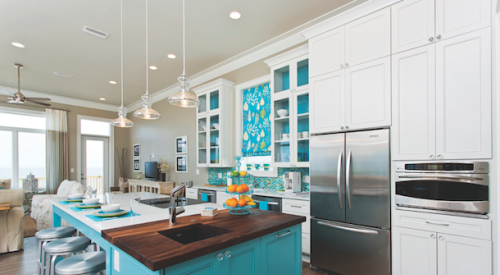PRODUCTS Editor Nigel F. Maynard sits down with two designers who each weigh in on how IKEA cabinets play into residential home design.
Many residential professionals turn to IKEA cabinets when working with a tight budget. The frameless European cabinet style the company offers cannot be found as available and as cheap anywhere else, says Jillian Lare, owner of Jillian Lare Interior Design in Des Moines, IA.
“I love IKEA cabinets,” says Lare. “I put them in three homes of my own now .... One of the reasons that I’ll recommend the IKEA cabinets is if somebody is on a tight budget, but also if they have a tight space and we really need to get the most out of every square inch.”
Lare even put IKEA cabinets into a multi-million dollar home in San Francisco last year and says clients seek her out knowing she uses them.
But Paul McAlary, president and senior designer at Main Line Kitchen Design, remains staunchly against the alternative.
“It’s not very hard to find many, many, many different cabinet brands that are well constructed, and IKEA is not one of them,” says McAlary. “There’s many, many, many brands to choose from. All that are good values and many that are far better made than IKEA and equal or less expensive—and already come built.”
[ Read More: NEED LOW-COST CABINETS WITH HIGH STYLE? CONSIDER THESE 11 CHEAP OPTIONS ]
Transcript:
IKEA, the swedish company that has built its reputation offering flat pack or ready to assemble furniture with funny sounding names has become a force in the American market with its low-cost high design offerings and stores throughout the country.
IKEA has solidified its brand with the American consumer. The company's furniture and accessories are popular among apartment runners, college students, and new homebuyers but its kitchen cabinets are also a hit with homeowners who are remodeling on a dime. Surprisingly, the cabinets have become popular among residential construction professionals as well.
Today, architects, architectural designers, kitchen and bath designers, builders, and remodelers
turn to IKEA when they are working with a tight budget when they're looking for the modern European aesthetic for which IKEA is known. Such professional Jillian Lare, a designer in Des Moines, IA
The Argument For IKEA Cabinets
Lare: “We do residential almost 100% residential remodeling design, new construction design, and all the way through decorating, accessorizing, styling, here in the Des Moines, Iowa metro and also and also beyond.”
Maynard: “Okay and so obviously you've designed many kitchens as part of your work. How do you typically think about kitchen design and selecting materials for your kitchen?”
Lare: “Well, when I'm starting a kitchen design and looking at two aspects of it. There's the function of it and there's the aesthetic of it. And the function of it largely drives what recommendations I will make on the material side to begin with and then of course i'm going to pull aesthetics into it i mean we all want the kitchen to look beautiful and reflect the client's style and be appropriate to the architecture of the home, but i am a former engineer and i cannot get
away from being largely function driven so i'm very pragmatic in that way.
I guess the other thing that's going to drive the recommendations I make is going to be budget and budget combined with the client's vision for how long they're going to stay in their home as well as the home's relative market value.
You know when I'm looking at specifying the cabinets, for example, I am not going to recommend you know the highest end European built cabinetry for a home with a value that wouldn't support that or would it make sense for that neighborhood. So there's a lot of different factors that go into it.”
The Argument Against IKEA Cabinets
Maynard: But not all professionals are fans of this low-cost cabinet option.
One who is a staunch opponent of IKEA is Paul McAlary, president and senior designer at Main Line Kitchen Design, just outside Philadelphia.
McAlary: “It's not very hard to find many, many, many different cabinet brands that are well constructed. You know IKEA is not one of them but there's many many many brands to choose from all that are good values and many that are far better made than ikea and equal or less expensive and already come built, so that you don't have to build them yourself.”
Maynard: “So if you if someone were to say to you, ‘What are the hallmarks of a well-made cabinet box?’ What would those features include?”
McAlary: “There's two ways cabinets are made. Either cabinets will be framed in which case they have a solid wood frame on the front that's almost always three quarters of an inch thick solid wood. It's usually a half one and a half inches wide that frames the whole cabinet, goes around each individual drawer box. That's one.
And then the sides of the cabinets are attached into the front of that frame and that frame actually holds most of the weight of the drawers. And the doors are all attached to that frame and that's one way to make a cabinet the way IKEA cabinets are made. It’s called frameless construction and flameless construction started in Europe because wood is so much more expensive in Europe than it is in the United States.
In the United States, frameless cabinets aren't more expensive than frame cabinets but in Europe, they couldn't afford to make framed cabinets so only very rich people getting incredibly expensive cabinetry would get frame cabinets in the past. So a frameless cabinet is simply a box that has no front to it, that just has an open front and then four sides top bottom side, side and the back and so there's not really anything that's holding that cabinet square”








